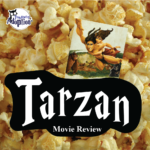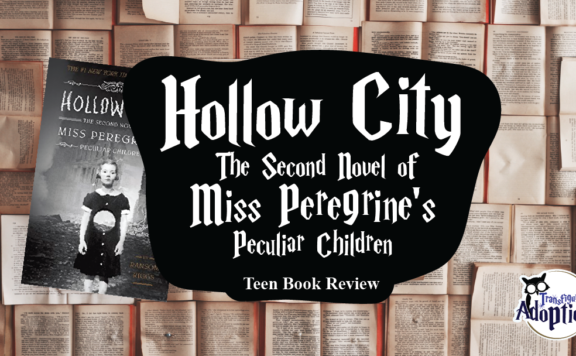Transfiguring Adoption’s Overview:
I have always felt like Tarzan was one of Disney’s underrated classics. Coming out in 1999 it was lumped in as part of Disney’s slump that followed the big hits of the early 90s. However, with it finally being added to the Disney+ platform it’s likely to find a new audience. It tells the age-old story of a boy raised by wild animals (in this case Gorillas) and how things unfold as he is introduced to his own species. As with many Disney movies the soundtrack is fantastic and for me is what really makes the movie. Many of the songs (Two Worlds, You’ll be in My Heart, and Strangers like Me) even have lyrics that relate to themes and struggles found in foster care and adoption!
I was somewhat surprised to see that the movie had a G rating. While there was nothing overly violent or offensive (no mentions of sex, no modern weapons, no foul language, etc.), there are a good amount of moments of peril and the movie is fairy action-packed and fast paced. I normally think of a G rating being applied to movies that are very low-key, and appropriate for very young children. While Tarzan is likely appropriate for all ages of children, I would be mindful of the level of action- especially in the opening sequence (which involves a fire, shipwreck, and leopard attack) and the final act of the movie which includes a lot of fighting between the men and gorillas.
** Spoilers Could Be Ahead **
How Is This Relevant To Adoption & Foster Care?
While on the surface one wouldn’t immediately think of Tarzan as a story that addresses Foster Care or Adoption in a traditional sense, it is absolutely relevant. Tarzan loses his parents as an infant and is taken in by a mother Gorilla, Kala, and raised as her son. Tarzan grows up in the jungle not fully understanding who he is or where he came from and facing challenges with acceptance by his peers and adoptive father figure for being different. These are struggles that almost all children who have experienced foster care or adoption can relate to.
When other humans arrive in the jungle and Tarzan sees them for the first time, he is overwhelmed with curiosity about these people who are like him. This curiosity sometimes leads him to engage in reckless behavior as he strives to learn as much as possible about them, even when it may not be safe. This may be similar to the desire adopted or foster children have to know more about their birth families. While Jane and her father aren’t actually related to Tarzan biologically, they are a link to his past and he is therefore compelled to find out more. In the end we see Tarzan reconcile these two parts of himself and ultimately decide that he belongs with his adoptive family, but he maintains a relationship with Jane and Dr. Porter.
Discussion Points:
- Accepting those who are different
Throughout the movie Kerchak, Tarzan’s adoptive father, struggles to accept Tarzan as part of the family because he is different. When Kala brings him home as a baby Kerchak declares that he’s “not our kind” and frequently says that Tarzan will “never be one of us”. Kala, Tarzan’s adoptive mother, on the other hand repeatedly declares her love for the baby and always treats him as though he is as much her son as any gorilla. When Tarzan struggles with his identity and wishing he looked more like his family Kala reminds him of all the ways in which they are the same and ultimately, they both share a heartbeat and that’s what matters. Tarzan challenges Kerchak’s views at one point asking, “Why are you threatened by anyone different from you?”. Watching these two parental figures and the different ways in which they approach Tarzan can be a great jumping off point for a conversation about acceptance and what that might look like. We do see a redemption arc for Kerchak and at the end of the movie he says to Tarzan, “forgive me for not understanding that you have always been one of us,” and finally calls Tarzan his son. Foster and adoptive kids might be a different race or of a different cultural background than their caregivers which may lead to many of the same feelings and questions that Tarzan has about how he is different from his adoptive mother. It’s important to acknowledge these feelings and also talk about the right and wrong ways to approach those who look or act differently
. - Reconciling two different families/worlds
Tarzan is taken in by Kala and the gorillas from a very young age and grows up with them as his family. As a young adult he is introduced to other humans for the first time and finds that he is compelled to find out more about them and spend time with them. This leads him to questioning his identity and learning about his parents and where he came from. Tarzan struggles to reconcile these two identities- he wants to remain loyal to his adoptive family whom he has grown up with and loves but he also wants to be a part of this human world and learn more about his past. Foster and adoptive kiddos often feel similarly in regard to their adoptive or foster family and their biological families. They can feel torn in two and uncertain how their feelings and interactions with one might affect the other. It’s important to talk about how it’s okay to feel a part of more than one family or world and help them find ways to reconcile these two parts of themselves so they don’t feel so torn in two. Looking at Tarzan’s journey and how he deals with this may help kids be able to better articulate their own feelings and experiences. - Loving those who aren’t physically with you
Towards the end of the movie, Kala shows Tarzan his childhood home and gives him information about his past and family. Kala can see that Tarzan is struggling with the decision to either stay here with his adoptive gorilla family or to go with Jane and her family to be with the other humans. In a touching exchange She tells him, “I just want you to be happy.” He responds with, “No matter where I go, you will always be my mother,” and she replies, “And you’ll be in my heart. Always.” Watching this exchange can be a great way to start a discussion with children about the endurance of love which is an important part of dealing with the various losses associated with foster care and adoption. You can talk about how their biological families love them, even if they aren’t able to parent them right now and how you’ll always love them even if your home isn’t their permanent one. They may one day move into an adoptive home or return to their bio family but that doesn’t mean that you will love them any less or that they’ll stop being a part of your family. For older children and teens this may also be something they struggle with as they prepare to leave the home to go to college or out into the adult world. “You’ll be in my Heart” is a great anthem that goes along with this theme.
Cautionary Points:
- Loss of Parent/Parent Figure
Both of Tarzan’s parents are killed in a leopard attack while he is an infant. We don’t see the actual attack or death, but we do see Kala the Gorilla find their bodies and bloody leopard prints. This may be upsetting for children who have lost a parent or someone else close to them. At the end of the movie we also see Kerchak, Tarzan’s adoptive father and head of the Gorilla troop get shot and dies after finally accepting Tarzan which is a hard scene to watch. - Natural Disasters
The movie opens with a shipwreck and fire. Baby Tarzan and both of his parents escape in a lifeboat but there are tense moments during the escape. If children in your care have experienced a natural disaster involving drowning or fire this may be a difficult scene for them to view.
- Moments of Mild/Moderate Peril
In addition to the shipwreck/leopard attack sequence at the start of the film, there are several other tense chases and fighting sequences. A group of small, but somewhat scarily depicted monkeys chase Jane and Tarzan through the treetops. Tarzan fights a leopard in hand-to-hand combat, and there is a lengthy scene in the film’s climax where Clayton and the other hunters are attacking the gorillas, attempting to put them in cages, threatening them with guns and a somewhat intense chase/fight sequence between Clayton and Tarzan which results in Clayton’s death. Children who have experienced trauma often have a more difficult time regulating their emotions and watching a movie that is fast paced and full of action sequences can trigger their ‘fight-or-flight’ response and lead to their engaging in trauma behaviors. - Mild Bullying
When Tarzan is young, some of the other gorillas tease him and call him names for being different. He is left out and called things like ‘hairless wonder’ and ‘freaky looking’. This doesn’t last very long however, and he quickly makes friends with Terk and Tantor who accept him despite his differences. - Rejection by parent figure
From the moment Kala brings him home, Kerchak, her mate and head of the Gorilla Troop does not accept Tarzan as part of the family. He constantly points out that Tarzan is different and doesn’t belong. He says hurtful things like “I said he could stay but that doesn’t make him my son” and “he will never be one of us”. This is a constant source of harm to Tarzan as he grows up and longs to be accepted. Children who have dealt with rejection by a caregiver may relate to Tarzan’s struggle and therefore this may be upsetting for them to watch.
[Donate to this Project]
About the Author: Jenn Ehlers
Jenn is a central Virginia native who received her BA in Psychology from the University of Virginia in 2012. Since then she has worked for a local mental health agency and the Department of Social Services in various capacities and has been involved in her community’s efforts to create a Trauma Informed Network. Currently Jenn works in vocational rehab and mentors youth in foster care. When she isn’t working, Jenn enjoys writing stories, anything and everything Harry Potter, and spending time with her niece and nephew.
**Transfiguring Adoption is a nonprofit organization seeking to nurture growth in foster and adoptive families by giving a HOOT about their families. Transfiguring Adoption does not intend for its reviewers nor its review to be professional, medical or legal advice. These reviews and discussion guides are intended to help parents to better be able to connect and understand their children who come from traumatic backgrounds.


